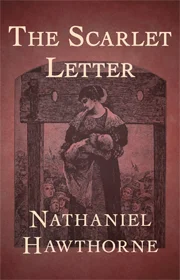
“The Scarlet Letter” by Nathaniel Hawthorne is a captivating tale set in the Puritanical society of 17th-century Massachusetts. The narrative follows Hester Prynne, a woman marked with a scarlet letter ‘A’ for committing adultery. As she navigates the harsh judgment and isolation imposed by her community, the story weaves a tapestry of sin, guilt, and redemption. The characters, including the tormented Reverend Dimmesdale and the vengeful Roger Chillingworth, add layers of complexity to the plot. Against the backdrop of a rigid and judgmental society, the novel explores the human condition, making it a timeless exploration of morality and self-discovery.
Read The Scarlet Letter Flipbook:
Listen to The Scarlet Letter Audiobook:
Title: The Scarlet Letter
Author: Nathaniel Hawthorne
Genre: Historical Fiction, Romance
Publication Date: 1850
Setting: Puritan Massachusetts Bay Colony in the mid-17th century
Main Characters:
• Hester Prynne: The protagonist, a woman who is publicly shamed for committing adultery.
• Reverend Arthur Dimmesdale: The local minister and Hester’s secret partner in sin.
• Roger Chillingworth: Hester’s estranged husband who seeks revenge.
• Pearl: Hester’s daughter, born out of the illicit affair.
Plot Summary: The story revolves around Hester Prynne, who is condemned for adultery and forced to wear a scarlet letter ‘A’ as a mark of shame. As she grapples with societal judgment and isolation, the narrative explores themes of sin, guilt, and redemption. The mysterious identity of Pearl’s father and the torment of Reverend Dimmesdale add complexity to the plot.
Themes:
• Sin and Redemption
• Guilt and Shame
• Hypocrisy in Puritan Society
• Individual vs. Society
Significance: “The Scarlet Letter” is a classic work of American literature, known for its exploration of moral and psychological themes. It delves into the consequences of sin and the complexities of human nature, making it a timeless and thought-provoking novel.
Adaptations: The novel has been adapted into various films, plays, and other literary works, attesting to its enduring cultural impact.
Symbolic ‘A’: The scarlet letter ‘A’ worn by Hester Prynne symbolizes adultery but evolves throughout the story to represent various aspects, such as “able” and “angel.”
Historical Context: Nathaniel Hawthorne, the author, was deeply influenced by his Puritan ancestors and the history of Salem witch trials, which is reflected in the novel’s setting and themes.
Puritanical Society: The novel critiques the rigid and judgmental nature of Puritan society, exploring the consequences of public shaming and the hypocrisy of moral standards.
Ambiguity of Sin: The narrative keeps the reader guessing about the identity of Pearl’s father, adding an element of mystery and emphasizing the complex nature of sin.
Nature Imagery: Hawthorne frequently uses nature as a backdrop, with the wild forest contrasting the strict Puritanical town, symbolizing freedom and the untamed aspects of human nature.
Irony in Names: The names of characters carry symbolic significance; for instance, Hester’s daughter is named Pearl, representing something precious born out of strife.
Dimmesdale’s Struggle: Reverend Dimmesdale’s internal struggle with guilt and the burden of his secret sin adds a psychological dimension to the narrative, showcasing the human cost of hidden transgressions.
Chillingworth’s Transformation: Roger Chillingworth, initially Hester’s estranged husband, transforms from a wronged husband to a malevolent force seeking revenge, highlighting the destructive power of resentment.
Author’s Ancestry: Nathaniel Hawthorne’s great-great-grandfather, Judge John Hathorne, was a key figure in the Salem witch trials, and Hawthorne added the “w” to his name to disassociate himself from this dark chapter in history.
Literary Legacy: “The Scarlet Letter” has become a staple in American literature, frequently studied in schools and inspiring numerous adaptations in various art forms, cementing its enduring impact on culture.